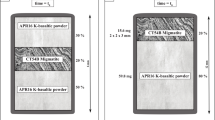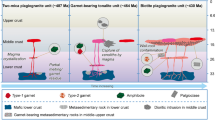Abstract
Amphibole-bearing mafic inclusions (low to medium-K high-alumina basalt to basaltic andesite) comprise 4.1 vol% of calc-alkaline rhyolite and rhyodacite lavas on Akrotiri Peninsula, Santorini, Greece. Physical features indicate a magmatic origin for the inclusions, involving mingling with the host silicic magma and quenching. Water contents of the mafic magmas are estimated to have been above 4% at water pressures of 1.8 kbars or more at temperatures of approximately 950–1,000 °C. Three evolutionary stages are inferred in their petrogenesis. In the first stage infiltration of slab fluids promotes partial melting in the mantle to generate primitive wet basaltic magmas enriched in LREE, LILE, Th and U in comparison to N-type MORB. In the second stage storage and crystal differentiation of primitive magmas occurred in the lithospheric mantle or deep crust, involving olivine, spinel and clinopyroxene followed by amphibole and plagioclase. In the third stage differentiated mafic magma intrudes into porphyritic silicic magma at shallower crustal levels (estimated at 7–10 km). Mingling and quenching of the mafic magmas within the silicic host causes chemical or physical interactions between the inclusions and the host prior to and during eruption. The silicic lavas have geochemical affinities with the mafic inclusions, but are relatively depleted in MREE, HREE and Y and enriched in Rb relative to Ba and K. These observations are consistent with involvement of amphibole in magma genesis due either to crystal differentiation from wet basalt or to partial melting of mafic rocks with residual amphibole. Crystallization of wet basalt in the deep crust is preferred on the basis of physical considerations.
















Similar content being viewed by others
References
Annen C, Sparks RSJ (2002) Effects of repetitive emplacement of basaltic intrusions on thermal evolution and melt generation in the deep crust. Earth Planet Sci Lett 203:937–955
Bacon CR (1986) Magmatic inclusions in silicic and intermediate volcanic rocks. J Geophys Res 91:6091–6112
Bailey EH, Kemp AJ, Ragnarsdottir KV (1993) Determination of uranium and thorium in basalt and uranium in aqueous solution by inductively coupled plasma mass spectrometry. J Anal Atom Spectrom 8:551–556
Bottazzi P, Tiepolo M, Vannucci R, Zanetti A, Brumm R, Foley SF, Oberti R (1999) Distinct site preferences for heavy and light REE in amphibole and the prediction of Amph/L DREE. Contrib Mineral Petrol 137:36–45
Carroll MR, Holloway JR (1994) Volatiles in magma. Mineral Soc Am Rev Mineral 30
Clynne MA (1999) A complex magma mixing origin for rocks erupted in 1915, Lassen Peak, California. J Petrol 40:105–132
Couch S, Sparks RSJ, Carroll MR (2001) Mineral disequilibrium in lavas explained by convective self-mixing in open magma chambers. Nature 411:1037–1039
Dalpé C, Baker DR (2000) Experimental investigation of large-ion-lithophile-elements, high-field-strength-element and rare earth element partitioning between calcic amphibole and basaltic melt: the effects of pressure and oxygen fugacity. Contrib Mineral Petrol 140:233–250
Davis E, Gartzos E, Dietrich VJ (1998) Magmatic evolution of the Pleistocene Akrotiri volcanoes. In: Casale R, Fytikas M, Sigvaldasson G, Vougioukalakis G (eds) The European laboratory volcanoes. Proc 2nd Worksh, Santorini, Greece, 2–4 May 1996, pp 49–68
Dietrich VJ, Davis E, Gartzos E (1998) Amphibole in rhyodacites and dacites from the Akrotiri volcanoes and the complexities of discontinuous fractional crystallization. In: Casale R, Fytikas M, Sigvaldasson G, Vougioukalakis G (eds) The European laboratory volcanoes: Proc 2nd Worksh, Santorini, Greece, 2–4 May 1996, pp 69–80
Dewey JE, Pittman III WC, Ryan WBF, Bonnin J (1973) Plate tectonics and evolution of the Alpine system. Geol Soc Am Bull 84:3137–3180
Draper DS, Johnston AD (1992) Anhydrous PT phase relations of an Aleutian High-Mg basalt—an investigation of the role of olivine-liquid reaction in the generation of arc high-alumina basalt. Contrib Mineral Petrol 112:501–519
Druitt TH, Edwards L, Mellors RM, Pyle DM, Sparks RSJ, Lanphere M, Davies M, Barreirio B (1999) Santorini Volcano. Mem Geol Soc Lond 19:1–165
Eggler DH (1972) Amphibole-stability in H2O-undersaturated calcalkaline melts. Earth Planet Sci Lett 15:38–54
Gaetano GA, Grove TL (1998) The influence of water on melting mantle peridotite. Contrib Mineral Petrol 131:323–346
Gill JB (ed) (1981) Orogenic andesite and plate tectonics. Springer, Berlin Heidelberg New York
Harvey PK, Atkin BP (1982) Automated X-ray Fluorescence analysis. Sampling and analysis for the minerals industry. Spec Publ Inst Min Metall pp 17–26
Heiken G, Eichelberger JC (1980) Eruption at Chaos Crags, Lassen Volcanic National Park, California. J Volcanol Geotherm Res 7:443–481
Hildreth W (1981) Gradients in silicic magma chamber: implications for lithospheric magmatism. J Geophys Res 89:8441–8462
Holland TJB, Blundy JD (1994) Non-ideal interactions in calcic amphiboles and their bearing on amphibole plagioclase thermometry. Contrib Mineral Petrol 116:433–447
Huijsmans JPP (1985) Calc-alkaline Lavas from the Volcanic Complex of Santorini, Aegean Sea, Greece. Geol Ultraiectina 41:1–316
Huijsmans JPP, Barton M (1989) Polybaric evolution of two shield volcanoes from Santorini, Aegean Sea, Greece: evidence for zoned magma. J Petrol 30:583–625
Huijsmans JPP, Barton M, Salters VJM (1988) Geochemistry and evolution of calc-alkaline volcanic complex of Santorini, Aegean Sea, Greece. J Volcanol Geotherm Res 34:283–306
Jackson JA (1994) Active tectonics of the Aegean region. Ann Rev Earth Planet Sci 22:239–271
Leake BE, Woolley AR, Arps CES, Birch WD, Gilbert MC, Grice JD (1997) Nomenclature of amphiboles: Report of the subcommittee on amphiboles of the International Mineralogical Association, Commission on new minerals and mineral names. Am Mineral 82:1019–1037
Mann AC (1983) Trace element geochemistry of high-alumina basalt-andesite-dacite-rhyodacite lavas of the Main Volcanic Series of Santorini Volcano, Greece. Contrib Mineral Petrol 84:43–57
Miyashiro A (1974) Volcanic rock series in island arcs and active continental margins. Am J Sci 274:321–355
Moore G, Carmichael ISE (1998) The hydrous phase equilibria (to 3 Kbar) of an andesite and basaltic andesite from western Mexico: constraints on water content and conditions of phenocryst growth. Contrib Mineral Petrol 130:304–319
Murphy MD, Sparks RSJ, Barclay J, Carroll MR, Lejeune AM, Brewer TS, MacDonald R, Black S (1998) The role of magma mixing in triggering the current eruption of the Soufriere Hills Volcano, Montserrat. Geophys Res Lett 25:3433–3436
Murphy MD, Sparks RSJ, Barclay J, Carroll MR, Brewer TS (2000) Remobilization of andesite magma by intrusion of mafic magma at the Soufriere Hills Volcano, Montserrat, West Indies. J Petrol 41:21–42
Nicholls IA (1971) Petrology of Santorini volcanic rocks. J Petrol 12:67–119
Parkinson IJ, Pearce JA (1998) Peridotites from the Izu-Bonin-Mariana Forearc (ODP Leg 125): evidence for mantle melting and melt-mantle interaction in a supra-subduction zone setting. J Petrol 39:1577–1618
Pearce JA (1983) Role of the sub-continental lithosphere magma genesis at active continental margins. In: Hawksworth CJ, Norry MJ (eds) Continental basalt and mantle xenoliths. Shiva Publishing, Cheshire, pp 230–249
Pearce JA, Parkinson IJ (1993) Trace element models for mantle melting: application to volcanic arc petrogenesis. Geol Soc Spec Publ 76:373–403
Peccerillo A, Taylor SR (1976) Geochemistry of Eocene calc-alkalic rock from the Kastamonu area, northern Turkey. Contrib Mineral Petrol 58:63–81
Petford N, Gallagher K (2001) Partial melting of mafic (amphibolitic) lower crust by periodic influx of basaltic magma. Earth Planet Sci Lett 59:1–17
Pichavant M, Martel C, Bourdier JL, Scaillet B (2002) Physical conditions, structure and dynamics of a zoned magma chamber: Mont Pelee (Martinique, Lesser Antilles). J Geophys Res 107, (in press)
Roggensack K (2001) Unravelling the 1974 eruption of Fuego volcano (Guatemala) with small crystals and young melt inclusions. Geology 29:911–914
Rutherford MJ, Sigurdsson H, Carey S, Davis A (1985) The May 18, 1980 eruption of Mount St. Helens. 1. Melt composition and experimental phase equilibria. J Geophys Res 90:2929–2947
Sen C, Dunn T (1994) Dehydration melting of a basaltic composition amphibolite at 1.5 and 2 Gpa—implications for the origin of adakites. Contrib Mineral Petrol 117:394–409
Sisson TW (1994) Hornblende-melt trace-element partitioning measured by ion microprobe. Chem Geol 117:331–344
Sisson TW, Grove TL (1993a) Experimental investigations of the role of H2O in calc-alkaline differentiation and subduction zone magmatism. Contrib Mineral Petrol 113:143–166
Sisson TW, Grove TL (1993b) Temperatures and H2O contents of low-MgO high-alumina basalts. Contrib Mineral Petrol 113:167–184
Sisson TW, Layne GD (1993) H2O in basalt and basaltic andesite glass inclusions from four subduction-related volcanoes. Earth Planet Sci Lett 117:619–635
Sparks RSJ, Marshall L (1986) Thermal and mechanical constraints on magma mixing. J Volcanol Geotherm Res 29:99–124
Sun SS, McDonough (1989) Chemical and isotopic systematic of oceanic basalts: implication for mantle composition and processes. Geol Soc Spec Publ 42:313–345
Zhang Y (1999) H2O in rhyolitic glasses and melts measurement, speciation, solubility, and diffusion. Rev Geophys 37:493–516
Acknowledgements
The authors would like to thank Fred Anderson, Jon Blundy and John Schumacher for their comments; Tim Brewer for performing XRF analyses; and Tony Kemp for performing ICP-MS analyses. Jenni Barclay and Ed Stephens are thanked for their helpful reviews. The research was funded by an NERC fellowship for R.S.J.S. and Ministry of Sciences, Research and Technology of Iran.
Author information
Authors and Affiliations
Corresponding author
Additional information
Editorial responsibility: I. Parsons
Electronic Supplementary Material
Rights and permissions
About this article
Cite this article
Mortazavi, M., Sparks, R.S.J. Origin of rhyolite and rhyodacite lavas and associated mafic inclusions of Cape Akrotiri, Santorini: the role of wet basalt in generating calcalkaline silicic magmas. Contrib Mineral Petrol 146, 397–413 (2004). https://doi.org/10.1007/s00410-003-0508-4
Received:
Accepted:
Published:
Issue Date:
DOI: https://doi.org/10.1007/s00410-003-0508-4




